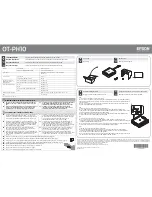
1086
BigIron RX Series Configuration Guide
53-1001810-01
Configuring IPv6 neighbor discovery
43
Each configured router interface on a link sends out a router advertisement message, which has a
value of 134 in the Type field of the ICMP packet header, periodically to the all-nodes link-local
multicast address (FF02::1).
A configured router interface can also send a router advertisement message in response to a
router solicitation message from a node on the same link. This message is sent to the unicast IPv6
address of the node that sent the router solicitation message.
At system startup, a host on a link sends a router solicitation message to the all-routers multicast
address (FF01). Sending a router solicitation message, which has a value of 133 in the Type field of
the ICMP packet header, enables the host to automatically configure its IPv6 address immediately
instead of awaiting the next periodic router advertisement message.
Because a host at system startup typically does not have a unicast IPv6 address, the source
address in the router solicitation message is usually the unspecified IPv6 address
(0:0:0:0:0:0:0:0). If the host has a unicast IPv6 address, the source address is the unicast IPv6
address of the host interface sending the router solicitation message.
Entering the ipv6 unicast-routing command automatically enables the sending of router
advertisement messages on all configured router Ethernet interfaces. You can configure several
router advertisement message parameters. For information about disabling the sending of router
advertisement messages and the router advertisement parameters that you can configure, refer to
“Enabling and disabling IPv6 router advertisements”
on page 1089 and
“Setting IPv6 router
advertisement parameters”
on page 1087.
Neighbor redirect messages
After forwarding a packet, by default, a router can send a neighbor redirect message to a host to
inform it of a better first-hop router. The host receiving the neighbor redirect message will then
readdress the packet to the better router.
A router sends a neighbor redirect message only for unicast packets, only to the originating node,
and to be processed by the node.
A neighbor redirect message has a value of 137 in the Type field of the ICMP packet header.
Setting neighbor solicitation parameters for duplicate address
detection
Although the stateless autoconfiguration feature assigns the 64-bit interface ID portion of an IPv6
address using the MAC address of the host’s NIC, duplicate MAC addresses can occur. Therefore,
the duplicate address detection feature verifies that a unicast IPv6 address is unique before it is
assigned to a host interface by the stateless autoconfiguration feature. Duplicate address
detection verifies that a unicast IPv6 address is unique.
If duplicate address detection identifies a duplicate unicast IPv6 address, the address is not used.
If the duplicate address is the link-local address of the host interface, the interface stops
processing IPv6 packets.
You can configure the following neighbor solicitation message parameters that affect duplicate
address detection while it verifies that a tentative unicast IPv6 address is unique:
•
The number of consecutive neighbor solicitation messages that duplicate address detection
sends on an interface. By default, duplicate address detection sends three neighbor
solicitation messages without any follow-up messages.
Summary of Contents for Brocade DCX
Page 40: ...xl BigIron RX Series Configuration Guide 53 1001810 01 ...
Page 72: ...lxxii BigIron RX Series Configuration Guide 53 1001810 01 ...
Page 88: ...16 BigIron RX Series Configuration Guide 53 1001810 01 Searching and filtering output 1 ...
Page 300: ...228 BigIron RX Series Configuration Guide 53 1001810 01 Displaying IP information 7 ...
Page 318: ...246 BigIron RX Series Configuration Guide 53 1001810 01 Deploying a LAG 8 ...
Page 418: ...346 BigIron RX Series Configuration Guide 53 1001810 01 SuperSpan 12 ...
Page 482: ...410 BigIron RX Series Configuration Guide 53 1001810 01 MRP CLI example 14 ...
Page 506: ...434 BigIron RX Series Configuration Guide 53 1001810 01 Displaying VSRP information 15 ...
Page 582: ...510 BigIron RX Series Configuration Guide 53 1001810 01 Viewing Layer 2 ACLs 20 ...
Page 634: ...562 BigIron RX Series Configuration Guide 53 1001810 01 Troubleshooting ACLs 21 ...
Page 642: ...570 BigIron RX Series Configuration Guide 53 1001810 01 Trunk formation 22 ...
Page 746: ...674 BigIron RX Series Configuration Guide 53 1001810 01 Displaying RIP filters 24 ...
Page 808: ...736 BigIron RX Series Configuration Guide 53 1001810 01 Displaying OSPF information 25 ...
Page 938: ...866 BigIron RX Series Configuration Guide 53 1001810 01 Displaying MBGP information 27 ...
Page 950: ...878 BigIron RX Series Configuration Guide 53 1001810 01 Using secure copy 28 ...
Page 988: ...916 BigIron RX Series Configuration Guide 53 1001810 01 Clearing IS IS information 29 ...
Page 1054: ...982 BigIron RX Series Configuration Guide 53 1001810 01 Sample 802 1x configurations 33 ...
Page 1108: ...1036 BigIron RX Series Configuration Guide 53 1001810 01 sFlow 39 ...
Page 1190: ...1118 BigIron RX Series Configuration Guide 53 1001810 01 Displaying RIPng information 44 ...
Page 1270: ...1198 BigIron RX Series Configuration Guide 53 1001810 01 Displaying ACLs 47 ...
Page 1310: ...1238 BigIron RX Series Configuration Guide 53 1001810 01 Displaying OSPFv3 information 48 ...
Page 1382: ...1310 BigIron RX Series Configuration Guide 53 1001810 01 Commands That Require a Reload D ...
Page 1435: ...BigIron RX Series Configuration Guide 1363 53 1001810 01 VSRP E ...
Page 1436: ...1364 BigIron RX Series Configuration Guide 53 1001810 01 VSRP E ...
















































